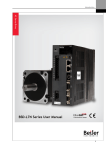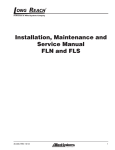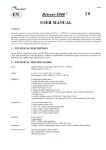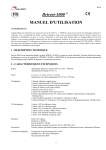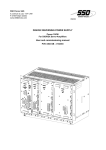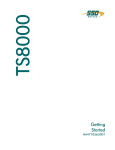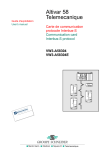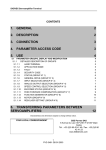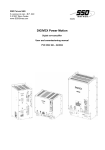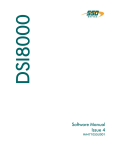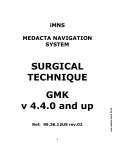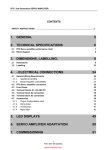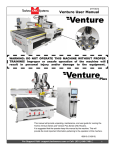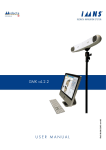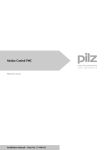Download PVD 3543 GB
Transcript
SSD Parvex SAS 8, avenue du Lac - B.P. 249 F-21007 Dijon Cedex www.SSDdrives.com DIGIVEX Motion Remote control using PDO messages PVD 3543 GB – 09/2005 PRODUCT RANGE 1- « BRUSHLESS » SERVODRIVES TORQUE OR POWER RANGES • ⇒ ⇒ ⇒ ⇒ ⇒ ⇒ ⇒ • ⇒ ⇒ ⇒ ⇒ • 2- BRUSHLESS SERVOMOTORS, LOW INERTIA, WITH RESOLVER Very high torque/inertia ratio (high dynamic performance machinery): NX -HX - HXA NX - LX High rotor inertia for better inertia load matching: HS - LS Varied geometrical choice : short motors range HS - LS or small diameter motors : HD, LD Voltages to suit different mains supplies : 230V three-phase for «série L - NX» 400V, 460V three-phase for «série H - NX» "DIGIVEX DRIVE" DIGITAL SERVOAMPLIFIERS SINGLE-AXIS DSD COMPACT SINGLE-AXIS DµD, DLD POWER SINGLE-AXIS DPD MULTIPLE-AXIS DMD "PARVEX MOTION EXPLORER" ADJUSTING SOFTWARE 1 to 320 N.m 0.45 to 64 N.m 3.3 to 31 N.m 3.3 to 31 N.m 9 to 100 N.m SPINDLE DRIVES • SPINDLE SYNCHRONOUS MOTORS ⇒ "HV" COMPACT SERIES ⇒ "HW" ELECTROSPINDLE,frameless, water-cooled motor • 3- From 5 to 110 kW up to 60,000 rpm "DIGIVEX" DIGITAL SERVOAMPLIFIERS DC SERVODRIVES • • • 4- "AXEM", "RS" SERIES SERVOMOTORS "RTS" SERVOAMPLIFIERS "RTE" SERVOAMPLIFIERS for DC motors + resolver giving position measurement 0.08 to 13 N.m SPECIAL ADAPTATION SERVODRIVES • • 5- "EX" SERVOMOTORS for explosive atmosphere "AXL" COMPACT SERIES SERVOREDUCERS POSITIONING SYSTEMS • • • ⇒ ⇒ ⇒ • Numerical Controls « CYBER 4000 » 1 to 4 axes "CYBER 2000" NC 1 to 2 axes VARIABLE SPEED DRIVE - POSITIONER SINGLE-AXIS DSM POWER SINGLE-AXIS DPM MULTIPLE-AXIS DMM ADJUSTMENT AND PROGRAMMING SOFTWARE PARVEX MOTION EXPLORER 5 to 700 N.m DIGIVEX Motion – Remote control using PDO messages TABLE OF CONTENTS 1. GENERAL POINTS 1.1 1.2 List of published DIGIVEX Motion manuals Introduction 3 3 3 2. "POSITION DRIVE WITH INTERPOLATION" MODE 4 2.1 General points 2.2 Setting parameters 2.3 Commissioning 2.4 Cycle 2.5 Mode exit 2.6 Safety Measures 2.6.1 EMCY Messages 2.6.2 SYNC Messages 2.6.3 PDO Messages 2.6.4 Power loss – Setting to zero torque 2.7 Maximum synchronization message rate 3. OTHER OPERATING MODES 4 4 4 4 6 6 6 6 6 7 7 8 3.1 General Points 3.2 Speed Drive Mode 3.2.1 Setting parameters 3.2.2 Commissioning 3.3 Profile Velocity Mode (Speed in unit1/s) 3.3.1 Setting parameters 3.2.2 Commissioning 3.4 Velocity Mode (Speed in rpm) 3.4.1 Setting parameters 3.4.2 Commissioning 3.5 Profile Torque Mode (torque drive) 3.5.1 Setting parameters 3.5.2 Commissioning 3.6 Condition Returns 3.6.1 Setting parameters 3.6.2 Commissioning 8 8 8 8 9 9 9 9 9 9 10 10 10 10 10 10 4. SETTING PARAMETERS 11 4.1 4.2 Operating mode selection Setting parameters for PDO messages 1 PVD 3543 GB 09/2005 11 13 DIGIVEX Motion – Remote control using PDO messages 4.2.1 PDO Rx Messages Control Word Operating mode Target Position Target Velocity VL Target Velocity Target Torque Torque Max 4.2.2 PDO Tx Messages Status Word Mode Of Operation Display Position Actual Value Velocity Actual Value VL Control Effort Torque Actual Value (0.01 Nm) Torque Actual Value (Nm) in_port pos_memo Master Actual Value PxStatus Word 14 15 15 16 16 16 16 16 17 18 18 18 18 19 19 19 19 19 19 19 Characteristics and dimensions subject to change without notice YOUR LOCAL CORRESPONDENT SSD Parvex SAS 8 Avenue du Lac / B.P 249 / F-21007 Dijon Cedex Tél. : +33 (0)3 80 42 41 40 / Fax : +33 (0)3 80 42 41 23 www.SSDdrives.com 2 PVD 3543 GB 09/2005 DIGIVEX Motion – Remote control using PDO messages 1. GENERAL POINTS 1.1 List of published DIGIVEX Motion manuals ♦ ♦ ♦ ♦ ♦ ♦ ♦ ♦ ♦ ♦ ♦ ♦ ♦ ♦ DIGIVEX Single Motion (DSM) User Manual DIGIVEX Power Motion (DPM) User Manual DIGIVEX Multi Motion (DMM) User Manual DIGIVEX Motion - CANopen DIGIVEX Motion - Profibus PME-DIGIVEX Motion Adjustment Manual DIGIVEX Motion Directory of Variables DIGIVEX Motion Programming DIGIVEX Motion - Cam Function PME Tool kit User and Commissioning Manual CANopen - CAN Bus Access via CIM03 CANopen - Remote control using PDO messages "Block Positioning" Application Software "Fly shear linear cutting" software application (DSM) (DPM) (DMM) ♦ "Rotary blade cutting" software application PVD3515 PVD3522 PVD3523 PVD3518 PVD3554 PVD3516 PVD3527 PVD3517 PVD3538 PVD3528 PVD3533 PVD3543 PVD3519 PVD3531 PVD3532 1.2 Introduction The aim of this document is to describe possible uses for CANopen PDO messages: • • • • • "Position control with interpolation" mode "Position drive" mode "Speed drive" mode "Torque drive" mode Condition returns 3 PVD 3543 GB 09/2005 DIGIVEX Motion – Remote control using PDO messages 2. "POSITION DRIVE WITH INTERPOLATION" MODE 2.1 General points A supervisor card must be used for the "position control with interpolation" mode. The card sends cyclic, synchronized position instructions to one or more axes via CANopen PDO messages. 2.2 Setting parameters This stage involves the determining of general DIGIVEX Motion parameters (Operating, Motor/Resolver, Servocontrol etc. Modes). Use the Parvex Motion Explorer software “Parameter Setting” tool to do this and refer to the PVD 3516 manual. Please refer to section 4 of the above document for parameter setting specificities linked to "Position drive with interpolation" operating modes. 2.3 Commissioning The supervisor must send a NMT "Start Remote Node" message for the DIGIVEX Motion PDO message to be acknowledged (see the DS301 v4.01 CanOpen standard). At the same time, DIGIVEX Motion waits for the supervisor to transmit a first synchronized message. It must receive a further 127 synchronized messages in order to determine the exact message frequency. During this phase, PDO Rx messages are not acknowledged. The supervisor must, therefore, wait before sending instructions. Remark: Afterwards, the synchronized message frequency (SYNC_period) is recalculated every 1024 periods in order to account for any possible time drift. 2.4 Cycle After this commissioning phase, PDO messages transmitted by the supervisor (PDO Rx) are acknowledged by DIGIVEX Motion and the position instruction (Target Position) is injected into the variable speed drive positioner trajectory generator in order to construct the position instruction and the speed and acceleration predictors necessary for the servocontrol algorithm. The trajectory generator used by the "Position drive with interpolation" mode is a trajectory generator specific to this mode. It uses 3 points (new instruction, instruction in progress and previous instruction) to generate the trajectory. 4 PVD 3543 GB 09/2005 DIGIVEX Motion – Remote control using PDO messages Position Pn Pn-1 Pn+1 SYNC_period t tn-1 tn tn+1 Synchronization (SYNC) messages are messages transmitted by the supervisor at exact and regular intervals (Do not go below 3 ms for correct running). They allow instruction acknowledgement synchronization. If several axes are being driven, instructions will be applied at the same moment to all variable speed drive postioners. The clocks of the different variable speed drive postioners are independent, therefore, the maximum acknowledgement phase difference between motion controllers is 250 µs (which corresponds to a variable speed drive postioner maximum sampling period). We recommend that you leave a timeframe of at least 300 µs between the last PDOrx message and its corresponding synchronization SYNC message. The PDOrxn message contains the Pn+1 position instruction which is applied at moment tn when the axis is at position Pn. SYNC_period Superviseur → Digivex Motion PDOrxn-1 PDOrxn SYNCn-1 SYNCn Digivex Motion → Superviseur environ 600 µs PDOtxn-1 PDOtxn t tn-1 tn DIGIVEX Motion can, in reply to the reception of a SYNC message transmitted by the supervisor, return a PDOtx message; the contents of which can be selected by the user (Status Word, Status Word + Mode Of Operation Display, Status Word + Position Actual Value, etc.). This is not obligatory (you can choose not to return a condition message). If this message is transmitted, it is sent about 600 µs after the acknowledgement of the synchronization SYNC message. A PDOtxn message contains values corresponding to time tn. 5 PVD 3543 GB 09/2005 DIGIVEX Motion – Remote control using PDO messages 2.5 Mode exit The supervisor can use the following procedure to stop the machine correctly at the end of the running process: • send a "Stop Remote Node" message so that the acknowledgement of PDO messages is not validated (see the DS301 v4.01 CanOpen standard) • stop PDO message transmission whilst still transmitting synchronization messages • disconnect the variable speed drive postioner (mains and auxiliary power supplies) or change the operating mode (for example, send a SDO message to change the variable speed drive postioner to "position drive" mode [drive_mode = 0]) • stop sending synchronization messages. No fault will be indicated. 2.6 Safety Measures 2.6.1 EMCY Messages An emergency (EMCY) message is transmitted when a variable speed drive postioner goes into fault, showing the supervisor and all other subscribers present on the CANopen bus that a problem has occurred. The message shows the nature of the fault. 2.6.2 SYNC Messages DIGIVEX Motion monitors the immediate frequency of synchronization messages during the running process. DIGIVEX Motion generates a minor fault (flashing "b") if the elapsed time between two successive messages is more than 1.1 times the calculated frequency. This fault does not stop the running process. DIGIVEX Motion generates a major fault (flashing "b") when synchronization messages are no longer transmitted or when 3 consecutive synchronization messages have been detected out of frequency. This fault causes an OK relay of the variable speed drive postioner to open (and therefore, if connection specifications have been respected, the power cuts out). The flashing "b" fault can be cleared with a SDO message (reset_cmd = 1). 2.6.3 PDO Messages The disappearance of PDO messages is not monitored. A fault is not generated if PDO instruction messages are no longer transmitted whilst synchronization messages are still being transmitted. Movement will stop naturally because position instructions are no longer being up-dated. Even so, beware of a sudden recovery of position instruction transmission! 6 PVD 3543 GB 09/2005 DIGIVEX Motion – Remote control using PDO messages 2.6.4 Power loss – Setting to zero torque A specific control makes remote control of the appliance easier for the supervisor in the event of power loss or setting to zero torque: • There is no forcing of the target position with the actual position value of the axis (contrary to other operating modes). • Tracking error monitoring is not suspended Two situations exist: • The supervisor has realized or is aware of the power loss or the setting to zero torque and decides to stop the machine correctly (stop PDO message transmission whilst synchronization messages are still being transmitted, power-down the variable speed drive postioner completely or change to "position drive" mode and stop sending synchronization messages). No fault will be indicated. • The supervisor has not realized that there is a problem and continues to transmit PDO and synchronization messages. DIGIVEX Motion will then generate a major fault (tracking error "U" fault) when the tracking error goes over its maximum authorized value (trackerror_max). Any risk of inopportune surges is therefore minimized should the power come back on or the torque be revalidated. 2.7 Maximum synchronization message rate The synchronization message frequency (SYNC_period) will depend on the number of axes and the number of PDO messages exchanged between the supervisor and each of the axes. Assuming that the CAN bus has 2 PDO messages per axis (1 transmitting and 1 receiving), the following minimum values will apply: 1 to 8 axes 9 to 12 axes > 12 axes SYNC_period ≥ 3 ms SYNC_period ≥ 4 ms SYNC_period ≥ 4 ms + 1 ms per group of additional 4 axes The SYNC_period frequency is bound to be a multiple of 1 ms and must be generated as regularly as possible. 7 PVD 3543 GB 09/2005 DIGIVEX Motion – Remote control using PDO messages 3. OTHER OPERATING MODES 3.1 General Points The use of PDO messages is not limited to the "position drive with interpolation" mode. All types of applications using PDO messages are possible. A supervisor card must be used for sending PDO messages. The card controls the intervals between the sending and the receiving of the PDO messages (sending instructions and receiving condition returns). The sequencing is carried out using synchronization (SYNC) messages transmitted by the supervisor card. The dialogue via PDO messages can only be established between a master appliance (supervisor) and slave appliances (DIGIVEX Motion variable speed drive positioner, keypad/display, input/output module, etc.), and never between two slave appliances. For all operating modes excepting the "position drive with interpolation" mode: • it is possible for the synchronization SYNC messages not to be cyclic • synchronization messages are not monitored • a licence is not required for work with PDO messages • internal interpolation is not carried out by the variable speed drive positioner between the various instructions transmitted to him 3.2 Speed Drive Mode 3.2.1 Setting parameters • Put the DIGIVEX Motion in speed drive mode: drive_mode = 1 • Set the parameters for PDO Rx with option "4: Control Word +Target Velocity" 3.2.2 Commissioning The supervisor must send a NMT "Start Remote Node" message, at the beginning of the process, for DIGIVEX Motion to validate the PDO message acknowledgement (see the DS301 v4.01 CANopen standard). Following this, DIGIVEX Motion waits for the supervisor to transmit a synchronization (SYNC) message before applying the last received PDO message instruction. This instruction is then recopied in the variable speed_value. The supervisor must send a "Stop Remote Node" message, at the end of the process, to cancel the validation of the PDO message acknowledgement (see the DS301 v4.01 CANopen standard). 8 PVD 3543 GB 09/2005 DIGIVEX Motion – Remote control using PDO messages 3.3 Profile Velocity Mode (Speed in unit1/s) 3.3.1 Setting parameters • • Put the DIGIVEX Motion in speed drive mode: drive_mode = 5 Set the parameters for PDO Rx using option 4 (Control Word + Target Velocity) 3.2.2 Commissioning The supervisor must send an NMT "Start Remote Node" message, at the beginning of the process, for DIGIVEX Motion to validate the PDO message acknowledgement (see the DS301 v4.01 CanOpen standard). Following this, DIGIVEX Motion waits for the supervisor to transmit a synchronization (SYNC) message before applying the last received PDO message instruction. This instruction is then recopied to the speed_value variable (speed expressed in unit1/s). The supervisor must send a "Stop Remote Node" message, at the end of the process, to cancel the validation of the PDO message acknowledgement (see the DS301 v4.01 CanOpen standard). 3.4 Velocity Mode (Speed in rpm) 3.4.1 Setting parameters • • Put the DIGIVEX Motion in speed drive mode: drive_mode = 7 Set the parameters for PDO Rx using option 4 (Control Word + Target Velocity) 3.4.2 Commissioning The supervisor must send an NMT "Start Remote Node" message, at the beginning of the process, for DIGIVEX Motion to validate the PDO message acknowledgement (see the DS301 v4.01 CanOpen standard). Next, DIGIVEX Motion waits for the supervisor to transmit a synchronization (SYNC) message before applying the last received PDO message instruction. This instruction (expressed in rpm) is then converted to unit1/s before being transferred in the speed_value variable. The supervisor must send a "Stop Remote Node" message, at the end of the process, to cancel the validation of the PDO message acknowledgement (see the DS301 v4.01 CanOpen standard). 9 PVD 3543 GB 09/2005 DIGIVEX Motion – Remote control using PDO messages 3.5 Profile Torque Mode (torque drive) 3.5.1 Setting parameters • • Put the DIGIVEX Motion in torque drive mode: drive_mode = 6 Set the parameters for PDO Rx using option 5 (Control Word + Target Torque) 3.5.2 Commissioning The supervisor must send an NMT "Start Remote Node" message, at the beginning of the process, for DIGIVEX Motion to validate the PDO message acknowledgement (see the DS301 v4.01 CanOpen standard). Next, DIGIVEX Motion waits for the supervisor to transmit a synchronization (SYNC) message before applying the last received PDO message instruction. This instruction (expressed in thousandths of motor rated torque [M0]) is then converted to Nm and recopied to the torque_value variable. The supervisor must send a "Stop Remote Node" message, at the end of the process, to cancel the validation of the PDO message acknowledgement (see the DS301 v4.01 CanOpen standard). 3.6 Condition Returns 3.6.1 Setting parameters • Set the parameters for one or more PDO Tx 3.6.2 Commissioning The supervisor must send a NMT "Start Remote Node" message, at the beginning of the process, for the variable speed drive positioners to validate the transmission of PDO condition return messages (see the DS301 v4.01 CANopen standard). Following this, the variable speed drive positioners wait for the supervisor to transmit a synchronization (SYNC) message in order to return a PDO message containing the condition return (The condition return corresponds to the condition of the variable speed drive positioner when the synchronization message was received). This PDO message will be transmitted about 600 µs after the synchronization message acknowledgement. The supervisor must send a "Stop Remote Node" message, at the end of the process, to cancel the validation of the PDO message acknowledgement (see the DS301 v4.01 CANopen standard). 10 PVD 3543 GB 09/2005 DIGIVEX Motion – Remote control using PDO messages 4. SETTING PARAMETERS 4.1 Operating mode selection Use the Parvex Motion Explorer software “Parameter Setting” tool. Select the required option from the Operating Modes/Options/Axis Control tab. Attention! The "CANopen position drive with interpolation" mode requires the presence of a "position drive with interpolation" licence. The other operating modes do not require licences. 11 PVD 3543 GB 09/2005 DIGIVEX Motion – Remote control using PDO messages This licence is obtained from Parvex. If the licence was not anticipated when the equipment was ordered, it is always possible to add it on at a later date by contacting your usual commercial wholesaler. The licence is validated in the "Diagnostic Assistance" tool by entering a code. The required code is based on the serial number of the appliance for which it was produced; therefore a code that is valid for one appliance will not be valid for another. Use of the "Position drive with interpolation" operating mode without a licence, results in a flashing F fault (Licence missing). 12 PVD 3543 GB 09/2005 DIGIVEX Motion – Remote control using PDO messages 4.2 Setting parameters for PDO messages Use the “Parameter Setting” tool to set the parameters for communication via PDO messages, Operating Modes/CanOpen tab. 13 PVD 3543 GB 09/2005 DIGIVEX Motion – Remote control using PDO messages 4.2.1 PDO Rx Messages These PDO messages relate to instructions sent by a supervisor. DIGIVEX Motion variable speed drive positioners are capable of managing up to 4 PDO messages of this type in read mode. PDO Rx 1 This field defines the PDO Rx 1 message content [corresponding parameter: PDO1_rx_cfg]. The selection is carried out using a drop-down list 0 : inactive (default value) 1 : Control Word 2 : Control Word + Mode Of Operation 3 : Control Word + Target Position 4 : Control Word + Target Velocity 5 : Control Word + Target Torque 6 : Control Word + VL Target Velocity 21 : Control Word + Torque Max (0.01 Nm) + Target Position 22 : Control Word + Torque Max (Nm) + Target Position 23 : Control Word + Current reduction (0,01A) + Target Position PDO Rx 2 PDO Rx 3 PDO Rx 4 The PDO message content is defined in accordance with DS402 v1.1 and DS301 v4.01 CANopen standards. This field defines the PDO Rx 2 message content [corresponding parameter: PDO2_rx_cfg]. The selection is carried out using a drop-down list This field defines the PDO Rx 3 message content [corresponding parameter: PDO3_rx_cfg]. The selection is carried out using a drop-down list This field defines the PDO Rx 4 message content [corresponding parameter: PDO4_rx_cfg]. The selection is carried out using a drop-down list 14 PVD 3543 GB 09/2005 DIGIVEX Motion – Remote control using PDO messages Control Word 16 bit coded condition word (0x6040 CanOpen index). Bit 0 1 2 3 4 Name Switch On Disable Voltage Quick Stop Enable Operation Operation Mode Specific 5 Operation Mode Specific 6 Operation Mode Specific 7 8 9 10 11 Reset Fault Halt ub0 ub1 pos_memo_cmd 12 13 14 15 out0 out1 out2 exec_en Action see DS402 v 1.1 CanOpen standard see DS402 v 1.1 CanOpen standard see DS402 v 1.1 CanOpen standard see DS402 v 1.1 CanOpen standard see DS402 v 1.1 CanOpen standard (Enable IP Mode if drive_mode = 3 or 4) see DS402 v 1.1 CanOpen standard (Set Immediat if drive_mode = 3 or 4) see DS402 v 1.1 CanOpen standard (Abs / Rel if drive_mode = 3 or 4) see DS402 v 1.1 CanOpen standard see DS402 v 1.1 CanOpen standard Reserved Reserved Manufacturer Specific - Allows the memorization of the actual axis position in the pos1_c variable during the change to zero resolver (function active on the rising front of pos_memo_cmd) Manufacturer Specific Manufacturer Specific Manufacturer Specific Manufacturer Specific - Program execution authorization Control Word takes action on drive Status Machine. The following sequence must be reproduced: At starting, the drive is in status “Switch on disabled” Program the 0x0006 value to go to drive status “Ready to switch on” Then the value 0x0007 to go to drive status “Switched on” Then the 0x000F value (or 0x007F if drive_mode = 3 or 4) validates torque and the DIGIVEX Motion operating: drive status “Operation enable” The 0x0007 value (or 0x0077 if drive_mode = 3 or 4) cancels torque validation: drive back to status “Switched on”. Operating mode Value 0 1 2 3 4 5 6 7 Action reserved Profile Position Mode Velocity Mode Profile Velocity Mode Profile Torque Mode reserved Homing Interpolated Mode Comments Position drive (corresponds to drive_mode = 4) Speed drive (corresponds to drive_mode = 7) Speed drive (corresponds to drive_mode = 5) Torque drive (corresponds to drive_mode = 6) mode not available from this instruction (use home_cmd = 1) Position Position drive with interpolation (corresponds to drive_mode = 3) 15 PVD 3543 GB 09/2005 DIGIVEX Motion – Remote control using PDO messages Target Position 32 integral bit signed instruction expressed in unit1 corresponding to the position to be reached (0x607A CANopen index). For a correct acknowledgement, put the variable speed drive positioner in "Position drive with interpolation" mode (drive_mode = 3) or "Profile Position Mode" (drive_mode = 4). Target Velocity 32 integral bit signed instruction expressed in unit1/s corresponding to the speed to be reached (0x60FF CANopen index). This instruction is recopied to the speed_value variable and is only acknowledged if the variable speed drive positioner is in "Profile Velocity Mode" (drive_mode = 5). VL Target Velocity 16 integral bit signed instruction expressed in rpm corresponding to the speed to be reached (0x6042 CANopen index). This instruction is converted into unit1/s before being transferred to the speed_value variable. It is only acknowledged if the variable speed drive positioner is in "Velocity Mode" (drive_mode = 7). Target Torque 16 integral bit signed torque instruction (0x6071 CANopen index) expressed in thousandths of motor rated torque (M0). This instruction is recopied to the torque_value variable and is only acknowledged if the variable speed drive positioner is in "Profile Torque Mode" (drive_mode = 6). Torque Max 16 integral bit unsigned variable (expressed in hundredths of Nm: PDO_rx no.21, or in Nm: PDO_rx no.22) showing the torque value not to be exceeded (torque limit). 16 PVD 3543 GB 09/2005 DIGIVEX Motion – Remote control using PDO messages 4.2.2 PDO Tx Messages These PDO messages relate to condition returns sent to a supervisor. DIGIVEX Motion variable speed drive positioners are capable of managing the transmission of up to 4 PDO messages of this type. PDO Tx 1 This field defines the PDO Tx 1 message content [corresponding parameter: PDO1_tx_cfg]. The selection is carried out using a drop-down list 0 : inactive (default value) 1 : Status Word 2 : Status Word + Mode Of Operation Display 3 : Status Word + Position Actual Value 4 : Status Word + Velocity Actual Value 6 : Status Word + VL Control Effort 21 : Status Word + Torque Actual Value (0.01 Nm) + Position Actual Value 22 : Status Word + in_port + pos_memo (PDO message transmitted after an event: following a change in status of any one of the in0 to in15 on/off control inputs. Reception of a SYNC message does not result in transmission of a PDO message). 23 : Master Actual Value (pos2) 24 : PxStatus Word + Torque Actual Value (0.01 Nm) + Position Actual Value 25 : PxStatus Word + Torque Actual Value (Nm) + Position Actual Value 26 : PxStatus Word + id_measure (0,01A) + Position Actual Value PDO Tx 2 PDO Tx 3 PDO Tx 4 The PDO message content is defined in accordance with DS402 v1.1 and DS301 v4.01 CANopen standards. This field defines the PDO Tx 2 message content [corresponding parameter: PDO2_tx_cfg]. The selection is carried out using a drop-down list This field defines the PDO Tx 3 message content [corresponding parameter: PDO3_tx_cfg]. The selection is carried out using a drop-down list This field defines the PDO Tx 4 message content [corresponding parameter: PDO4_tx_cfg]. The selection is carried out using a drop-down list 17 PVD 3543 GB 09/2005 DIGIVEX Motion – Remote control using PDO messages Status Word 16 bit coded condition word (0x6041 CanOpen index). Bit 0 1 2 3 4 5 6 7 8 9 10 11 12 13 14 15 Name Ready To Switch On Switched On Operation Enabled Fault Voltage Disabled Quick Stop Switch On Disabled Warning move_on Remote Target Reached Internal Limit Active Operation Mode Specific Operation Mode Specific exec_on torque_on Action see DS402 v 1.1 CanOpen standard see DS402 v 1.1 CanOpen standard see DS402 v 1.1 CanOpen standard see DS402 v 1.1 CanOpen standard see DS402 v 1.1 CanOpen standard see DS402 v 1.1 CanOpen standard see DS402 v 1.1 CanOpen standard see DS402 v 1.1 CanOpen standard Manufacturer Specific - authorized movement data see DS402 v 1.1 CanOpen standard see DS402 v 1.1 CanOpen standard see DS402 v 1.1 CanOpen standard see DS402 v 1.1 CanOpen standard see DS402 v 1.1 CanOpen standard Manufacturer Specific - programs running data Manufacturer Specific - validated torque data Mode Of Operation Display 8 bit coded condition word showing the operating mode in progress (0x6061 CANopen index). Value 0 1 2 3 4 5 6 7 Action reserved Profile Position Mode Velocity Mode Profile Velocity Mode Profile Torque Mode reserved Homing Interpolated Position Mode Comments position drive (corresponds to drive_mode = 4) speed drive (corresponds to drive_mode = 7) speed drive (corresponds to drive_mode = 5) torque drive (corresponds to drive_mode = 6) mode not available (use home_cmd = 1) position drive with interpolation mode (corresponds to drive_mode = 3) Position Actual Value 32 integral bit signed variable (0x6064 CANopen index) expressed in unit1 showing the value of the actual servocontrol axis position (corresponds to pos1). Velocity Actual Value 32 integral bit signed variable (0x606C CANopen index) expressed in unit1/s showing the value of the actual axis speed (corresponds to speed1). 18 PVD 3543 GB 09/2005 DIGIVEX Motion – Remote control using PDO messages VL Control Effort 16 integral bit signed variable (0x6044 CANopen index) expressed in rpm showing the value of the actual axis speed (corresponds to speed1 converted to rpm). Torque Actual Value (0.01 Nm) 16 integral bit signed variable expressed in hundredths of Nm showing the actual torque value. Torque Actual Value (Nm) 16 integral bit signed variable expressed in Nm showing the actual torque value. in_port 16 integral bit unsigned variable expressing the status of the logic input port (binary coded value of the status of the in0 to in15 inputs). Please refer to the PVD 3527 "DIGIVEX Motion Directory of Variables" Manual for further information. pos_memo 32 integral bit signed variable expressed in unit1 showing the memorized value of the actual axis position (pos1). Memorization is carried out following a change in the status of the in0 or in1 inputs (only the rising edge corresponding to level_in0 for in0 or level_in1 for in1 is acknowledged). Master Actual Value 32 integral bit signed variable expressed in unit2 showing the value of the actual measured axis position (corresponds to pos2). PxStatus Word 16 bit coded condition word. Bit 0 1 2 3 4 5 6 7 8 9 10 11 Name in0 in1 in2 in3 in4 in5 in6 in7 move_on ub10 ub11 pos_memo_result 12 drive_ok 13 14 15 Fault + Warning exec_on torque_on Action Manufacturer Specific Manufacturer Specific Manufacturer Specific Manufacturer Specific Manufacturer Specific Manufacturer Specific Manufacturer Specific Manufacturer Specific Manufacturer Specific - authorized movement data Manufacturer Specific Manufacturer Specific Manufacturer Specific - memorized position data (following a change to 1 by pos_memo_cmd, data automatically set to 0 after pos_memo_cmd reset) Manufacturer Specific - variable speed drive positioner ok data see DS402 v 1.1 CanOpen standard Manufacturer Specific - programs running data Manufacturer Specific - validated torque data 19 PVD 3543 GB 09/2005






















